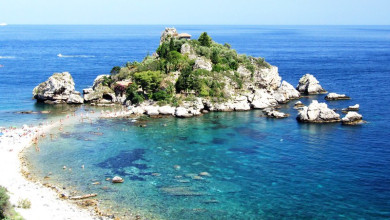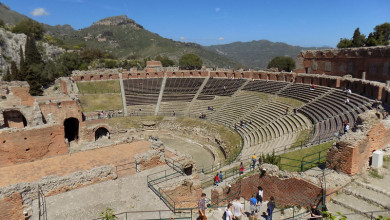The charm of Taormina
Guides
Taormina is located at 200 meters above sea level and looks down onto the Ionian Sea like a terrace, the prettiest you have ever seen. Over the centuries, this place of Taormina has fascinated wretched poets and writers and restless painters who decided to put down roots here, maybe so they could purify themselves by being in contact with such beauty and Nature or attracted by the unique, refreshing climate that makes it seem like it is always springtime.
An emotion that takes your breath away is what comes to everyone when they see the Greek-Roman Theater, this unbelievable work by mankind that stands on the mountain and from where one’s gaze drops down to the deep blue sea and to Etna, an unsettling presence that manages to stay in harmony with the landscape.
Taormina, city of art and a seaside resort, a place that fascinates and enraptures you, that seduces you and ties you to it, is still an elitist tourist resort today, for those people who love to sit at the tables of some elegant open-air coffee shop or on the terrace of some local restaurant every summer.
Going for a meal in one of the restaurants in Taormina is a real pleasure, due to the taste of the Sicilian food and the surroundings you will find yourself in. Many restaurants in fact have a garden with citrus fruit trees, and the perfume blends perfectly with the aroma of the food you are eating.
Fish is the true protagonist at the dinner table, however, especially swordfish and smaller fish like tuna, mackerel, sardines and anchovies that are always extra fresh, and that are prepared in various ways, according to the traditional Sicilian cooking recipes and served in all the restaurants in Taormina.
Getting There
Taormina is Sicily's main tourist destination; it is well serviced by important roads as well as by train and is also conveniently reachable by plane.
By car:
From Palermo take highway A19 Palermo-Catania and continue on A18 until destination. From Siracusa take the state road 114 to Catania and then take highway A18 until the exit at Taormina. From Agrigento take state highway 640 for Caltanisetta, continue then on highway A19 to Catania and then get on the A18 until destination. From Trapanitake A29 towards Palermo, continue on A19 Palermo-Catania and then take A18 up to destination.
Those coming from Continental Italy must continue on highway A3 Salerno-Reggio Calabria and exit on Villa San Giovanni to board the ferries that go to Messina. From Messina, highway A18 will get you in no time to Taormina.
By train:
Taormina is on the Messina-Catania line with direct and very frequent trains going both ways. If you are coming from Palermo or from other cities in Sicily, you will have to change trains. From Rome there are some direct trains for Taormina (via Naples), the trip lasts 9-10 hours. For times please consult the Trenitalia website or call the green number 89 20 21.
By plane:
The International Airport of Catania (CTA) is 50 km from Taormina. The airport offers connections with all the major Italian and European cities, including all the capitals. From the airport the Alibus shuttle service goes to Catania station every 20 minutes. There is a direct bus available from Etna Trasporti linking the Airport with Taormina.
Taormina History And Culture, Italy
The first contacts between Taormina and Greece were in 735 B.C. Later Dionysius the Old”, the tyrant ruler of Syracuse, besieged the area surrounding Monte Tauro as he wanted to conquer the plains. The inhabitants of this area managed to resist this brute force but not bureaucracy: in 392 B.C., thanks to an agreement with the Carthaginians, Dionysius managed to come into possession of the Mount. He sent Andromacus to govern the area, who then founded the city of Tauromenium.
To avoid any potential attacks, the city surrendered to the powerful Rome in 212 B.C. and became one of its colonies, a holiday resort for consuls and patricians who built many luxurious villas in this area, and which was a “cow to be milked” for the Empire. The Romans demanded heavier and heavier taxes from the city, and thus blocked the economic development of the territory.
With the fall of the Roman Empire (476 A.D.), the Byzantines began the slow, difficult conversion to Christianity, and Tauromenium became a bishop’s seat (and remained so until 1082). Muslims and Christians alternated in ruling the city until 962, when the Arabs finally conquered Taormina and renamed it Almoezia. During this period of Arab rule, the city enjoyed a period of splendor: important progress was made in agriculture (growing of oranges and lemons, irrigation systems), in philosophy, medicine and mathematics.
In 1078, the Norman Ruggero d’Altavilla, supported by the Pope, conquered Almoezia, returning it to Christian rule (even though Christians had been left quite free during Arab rule) and gave it back its original name. Norman rule also had a positive effect on the city, architecturally and culturally.
After the Normans, the Swabians arrived. During Frederick II’s rule (l194-1250) Taormina enjoyed a short but intense period of prosperity. However, the Pope (a Frenchman) did not approve the Swabians nor Swabian rule and crowned his fellow Frenchman Charles of Anjou as King of Sicily.
Taormina, together with other towns on the island, refused to acknowledge Charles of Anjou as their new monarch, and continued to support the Swabians, although they were unsuccessful. The hostility felt towards the French broke out into the revolt of the Sicilian Vespers in 1282.
After almost a century of conflict, Sicily passed into the hand of the Spanish and Palazzo Corvaja in Taormina became the seat of the Sicilian Parliament. There was then a period of stability that lasted for several centuries, in spite of the heavy taxation imposed by the Spanish.
Later, from 1713 onwards, Sicily fell under the rule of the Savoia dynasty, the Austrians and the under the Spanish once more. This latter period helped to develop Taormina, and important works were completed, such as the roads that connected the city of Messina to Catania and the one that joined the city to the sea. Spanish dominion lasted until August 3rd 1860 when Garibaldi's “Thousand” reached Taormina under the command of Nino Bixio and soon after all of Sicily was annexed to the Kingdom of Italy.


